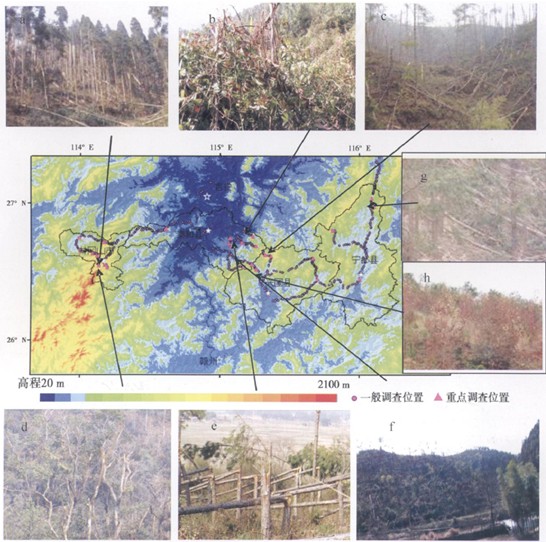Forest damage caused by ice-snow chaos in spring 2008 across southern China
An abrupt ice and snow storm disaster occurred once in half-a-century or even a-century in the spring of 2008, severe destroyed forests over a surprisingly large portion area of southern China. With lower temperature, sleet and freezing weather that lasted more than 20 days, 1.98×107 ha of forests or nearly 13% of China's forests were destroyed in 19 provinces.
A research team led by Professor SHAO Quanqin, Institute of Geographic Sciences and Natural Resource Research (IGSNRR) of Chinese Academy of Sciences (CAS), investigated the varied damage to forest caused by the spring ice-snow disaster and determined the possibility of Moderate Resolution Imaging Spectroradiometer (MODIS) Normalized Difference Vegetation Index (NDVI) on evaluating and reflecting the actual damage in regional scales.
A transect crossing Jinggang Mountain, Jitai Basin-Yushan Mountain and Wuyi Mountain, located in Southern Jiangxi Province, was selected as the case study area. The researchers integrated field investigated data to analyze the impacts of the ice and snow disturbance on forests.
The results indicated that the rule of matching tree species with site conditions should be abided as much as possible in forest ecosystem restoration and reconstruction program, and excessive turpentine activities should be restricted to guarantee the resistance of forest ecosystems facing disaster. Furthermore, the conservation and management of natural secondary forest were significant to prevent extreme ice-snow disasters and satisfy the demands of Land Use, Land-Use Change and Forestry (LULUCF) regarding increasing carbon sinks by forest management. These results are applied to evaluation of forest loss in this disturbance, and inspiration in restoration and reconstruction planning after the disaster.
The study has been published in Journal of Geographical Sciences. Shao, Q.Q, Huang, L., Liu, J.Y., Kuang W.H., Li J. Analysis of forest damage caused by the snow and ice chaos along a Transect across southern China in spring 2008. Journal of Geographical Sciences. 2011, 21(2): 219-234.
The work is supported by the National Natural Science Foundation of China (No.40971281), International Science and Technology Cooperative Program of China (No.2006DFB91920) and National Key Project of Scientific and Technical Supporting Programs (No.2006BAC08B00).

Investigated areas
Download attachments: